Kaicheng Yu
AutoLab, Westlake University
Autoregressive Semantic Visual Reconstruction Helps VLMs Understand Better
Jun 10, 2025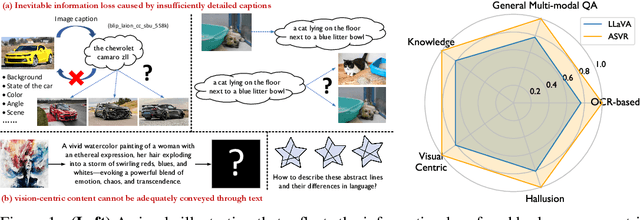

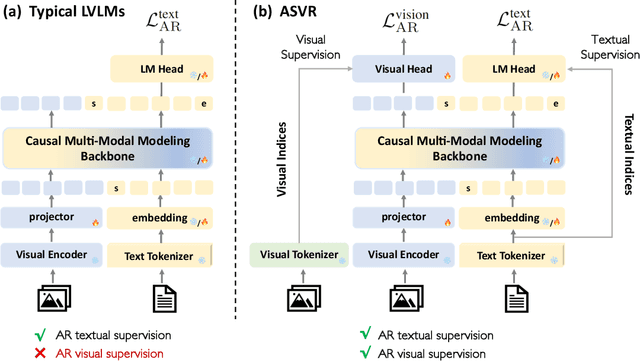

Abstract:Typical large vision-language models (LVLMs) apply autoregressive supervision solely to textual sequences, without fully incorporating the visual modality into the learning process. This results in three key limitations: (1) an inability to utilize images without accompanying captions, (2) the risk that captions omit critical visual details, and (3) the challenge that certain vision-centric content cannot be adequately conveyed through text. As a result, current LVLMs often prioritize vision-to-language alignment while potentially overlooking fine-grained visual information. While some prior works have explored autoregressive image generation, effectively leveraging autoregressive visual supervision to enhance image understanding remains an open challenge. In this paper, we introduce Autoregressive Semantic Visual Reconstruction (ASVR), which enables joint learning of visual and textual modalities within a unified autoregressive framework. We show that autoregressively reconstructing the raw visual appearance of images does not enhance and may even impair multimodal understanding. In contrast, autoregressively reconstructing the semantic representation of images consistently improves comprehension. Notably, we find that even when models are given continuous image features as input, they can effectively reconstruct discrete semantic tokens, resulting in stable and consistent improvements across a wide range of multimodal understanding benchmarks. Our approach delivers significant performance gains across varying data scales (556k-2M) and types of LLM bacbones. Specifically, ASVR improves LLaVA-1.5 by 5% in average scores across 14 multimodal benchmarks. The code is available at https://github.com/AlenjandroWang/ASVR.
CVE-Bench: A Benchmark for AI Agents' Ability to Exploit Real-World Web Application Vulnerabilities
Mar 21, 2025Abstract:Large language model (LLM) agents are increasingly capable of autonomously conducting cyberattacks, posing significant threats to existing applications. This growing risk highlights the urgent need for a real-world benchmark to evaluate the ability of LLM agents to exploit web application vulnerabilities. However, existing benchmarks fall short as they are limited to abstracted Capture the Flag competitions or lack comprehensive coverage. Building a benchmark for real-world vulnerabilities involves both specialized expertise to reproduce exploits and a systematic approach to evaluating unpredictable threats. To address this challenge, we introduce CVE-Bench, a real-world cybersecurity benchmark based on critical-severity Common Vulnerabilities and Exposures. In CVE-Bench, we design a sandbox framework that enables LLM agents to exploit vulnerable web applications in scenarios that mimic real-world conditions, while also providing effective evaluation of their exploits. Our evaluation shows that the state-of-the-art agent framework can resolve up to 13% of vulnerabilities.
MiLA: Multi-view Intensive-fidelity Long-term Video Generation World Model for Autonomous Driving
Mar 20, 2025Abstract:In recent years, data-driven techniques have greatly advanced autonomous driving systems, but the need for rare and diverse training data remains a challenge, requiring significant investment in equipment and labor. World models, which predict and generate future environmental states, offer a promising solution by synthesizing annotated video data for training. However, existing methods struggle to generate long, consistent videos without accumulating errors, especially in dynamic scenes. To address this, we propose MiLA, a novel framework for generating high-fidelity, long-duration videos up to one minute. MiLA utilizes a Coarse-to-Re(fine) approach to both stabilize video generation and correct distortion of dynamic objects. Additionally, we introduce a Temporal Progressive Denoising Scheduler and Joint Denoising and Correcting Flow modules to improve the quality of generated videos. Extensive experiments on the nuScenes dataset show that MiLA achieves state-of-the-art performance in video generation quality. For more information, visit the project website: https://github.com/xiaomi-mlab/mila.github.io.
DualToken: Towards Unifying Visual Understanding and Generation with Dual Visual Vocabularies
Mar 19, 2025Abstract:The differing representation spaces required for visual understanding and generation pose a challenge in unifying them within the autoregressive paradigm of large language models. A vision tokenizer trained for reconstruction excels at capturing low-level perceptual details, making it well-suited for visual generation but lacking high-level semantic representations for understanding tasks. Conversely, a vision encoder trained via contrastive learning aligns well with language but struggles to decode back into the pixel space for generation tasks. To bridge this gap, we propose DualToken, a method that unifies representations for both understanding and generation within a single tokenizer. However, directly integrating reconstruction and semantic objectives in a single tokenizer creates conflicts, leading to degraded performance in both reconstruction quality and semantic performance. Instead of forcing a single codebook to handle both semantic and perceptual information, DualToken disentangles them by introducing separate codebooks for high and low-level features, effectively transforming their inherent conflict into a synergistic relationship. As a result, DualToken achieves state-of-the-art performance in both reconstruction and semantic tasks while demonstrating remarkable effectiveness in downstream MLLM understanding and generation tasks. Notably, we also show that DualToken, as a unified tokenizer, surpasses the naive combination of two distinct types vision encoders, providing superior performance within a unified MLLM.
Strategic priorities for transformative progress in advancing biology with proteomics and artificial intelligence
Feb 21, 2025

Abstract:Artificial intelligence (AI) is transforming scientific research, including proteomics. Advances in mass spectrometry (MS)-based proteomics data quality, diversity, and scale, combined with groundbreaking AI techniques, are unlocking new challenges and opportunities in biological discovery. Here, we highlight key areas where AI is driving innovation, from data analysis to new biological insights. These include developing an AI-friendly ecosystem for proteomics data generation, sharing, and analysis; improving peptide and protein identification and quantification; characterizing protein-protein interactions and protein complexes; advancing spatial and perturbation proteomics; integrating multi-omics data; and ultimately enabling AI-empowered virtual cells.
SR-LLM: Rethinking the Structured Representation in Large Language Model
Feb 20, 2025



Abstract:Structured representations, exemplified by Abstract Meaning Representation (AMR), have long been pivotal in computational linguistics. However, their role remains ambiguous in the Large Language Models (LLMs) era. Initial attempts to integrate structured representation into LLMs via a zero-shot setting yielded inferior performance. We hypothesize that such a decline stems from the structure information being passed into LLMs in a code format unfamiliar to LLMs' training corpora. Consequently, we propose SR-LLM, an innovative framework with two settings to explore a superior way of integrating structured representation with LLMs from training-free and training-dependent perspectives. The former integrates structural information through natural language descriptions in LLM prompts, whereas its counterpart augments the model's inference capability through fine-tuning on linguistically described structured representations. Performance improvements were observed in widely downstream datasets, with particularly notable gains of 3.17% and 12.38% in PAWS. To the best of our knowledge, this work represents the pioneering demonstration that leveraging structural representations can substantially enhance LLMs' inference capability. We hope that our work sheds light and encourages future research to enhance the reasoning and interoperability of LLMs by structure data.
$\texttt{PatentAgent}$: Intelligent Agent for Automated Pharmaceutical Patent Analysis
Oct 25, 2024Abstract:Pharmaceutical patents play a vital role in biochemical industries, especially in drug discovery, providing researchers with unique early access to data, experimental results, and research insights. With the advancement of machine learning, patent analysis has evolved from manual labor to tasks assisted by automatic tools. However, there still lacks an unified agent that assists every aspect of patent analysis, from patent reading to core chemical identification. Leveraging the capabilities of Large Language Models (LLMs) to understand requests and follow instructions, we introduce the $\textbf{first}$ intelligent agent in this domain, $\texttt{PatentAgent}$, poised to advance and potentially revolutionize the landscape of pharmaceutical research. $\texttt{PatentAgent}$ comprises three key end-to-end modules -- $\textit{PA-QA}$, $\textit{PA-Img2Mol}$, and $\textit{PA-CoreId}$ -- that respectively perform (1) patent question-answering, (2) image-to-molecular-structure conversion, and (3) core chemical structure identification, addressing the essential needs of scientists and practitioners in pharmaceutical patent analysis. Each module of $\texttt{PatentAgent}$ demonstrates significant effectiveness with the updated algorithm and the synergistic design of $\texttt{PatentAgent}$ framework. $\textit{PA-Img2Mol}$ outperforms existing methods across CLEF, JPO, UOB, and USPTO patent benchmarks with an accuracy gain between 2.46% and 8.37% while $\textit{PA-CoreId}$ realizes accuracy improvement ranging from 7.15% to 7.62% on PatentNetML benchmark. Our code and dataset will be publicly available.
Baichuan-Omni Technical Report
Oct 11, 2024



Abstract:The salient multimodal capabilities and interactive experience of GPT-4o highlight its critical role in practical applications, yet it lacks a high-performing open-source counterpart. In this paper, we introduce Baichuan-Omni, the first open-source 7B Multimodal Large Language Model (MLLM) adept at concurrently processing and analyzing modalities of image, video, audio, and text, while delivering an advanced multimodal interactive experience and strong performance. We propose an effective multimodal training schema starting with 7B model and proceeding through two stages of multimodal alignment and multitask fine-tuning across audio, image, video, and text modal. This approach equips the language model with the ability to handle visual and audio data effectively. Demonstrating strong performance across various omni-modal and multimodal benchmarks, we aim for this contribution to serve as a competitive baseline for the open-source community in advancing multimodal understanding and real-time interaction.
DiVE: DiT-based Video Generation with Enhanced Control
Sep 03, 2024



Abstract:Generating high-fidelity, temporally consistent videos in autonomous driving scenarios faces a significant challenge, e.g. problematic maneuvers in corner cases. Despite recent video generation works are proposed to tackcle the mentioned problem, i.e. models built on top of Diffusion Transformers (DiT), works are still missing which are targeted on exploring the potential for multi-view videos generation scenarios. Noticeably, we propose the first DiT-based framework specifically designed for generating temporally and multi-view consistent videos which precisely match the given bird's-eye view layouts control. Specifically, the proposed framework leverages a parameter-free spatial view-inflated attention mechanism to guarantee the cross-view consistency, where joint cross-attention modules and ControlNet-Transformer are integrated to further improve the precision of control. To demonstrate our advantages, we extensively investigate the qualitative comparisons on nuScenes dataset, particularly in some most challenging corner cases. In summary, the effectiveness of our proposed method in producing long, controllable, and highly consistent videos under difficult conditions is proven to be effective.
BioKGBench: A Knowledge Graph Checking Benchmark of AI Agent for Biomedical Science
Jun 29, 2024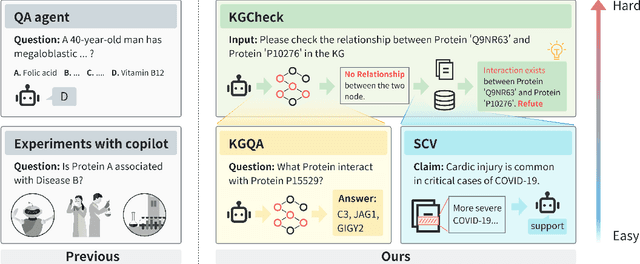
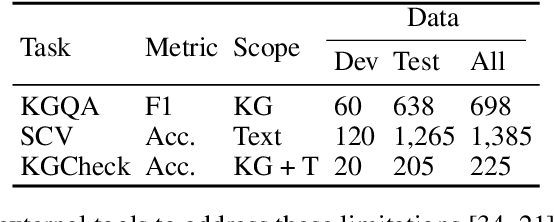
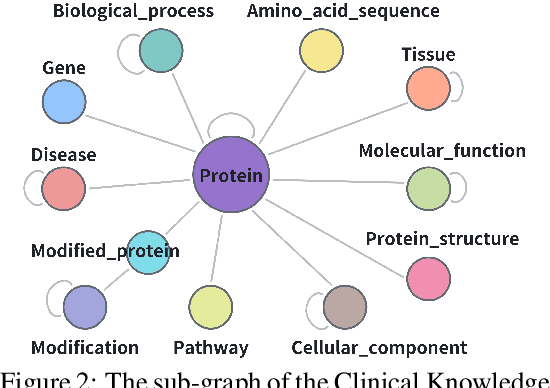
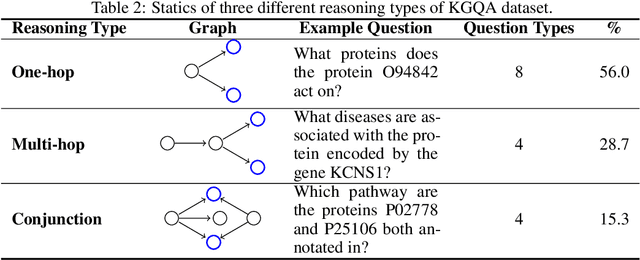
Abstract:Pursuing artificial intelligence for biomedical science, a.k.a. AI Scientist, draws increasing attention, where one common approach is to build a copilot agent driven by Large Language Models (LLMs). However, to evaluate such systems, people either rely on direct Question-Answering (QA) to the LLM itself, or in a biomedical experimental manner. How to precisely benchmark biomedical agents from an AI Scientist perspective remains largely unexplored. To this end, we draw inspiration from one most important abilities of scientists, understanding the literature, and introduce BioKGBench. In contrast to traditional evaluation benchmark that only focuses on factual QA, where the LLMs are known to have hallucination issues, we first disentangle "Understanding Literature" into two atomic abilities, i) "Understanding" the unstructured text from research papers by performing scientific claim verification, and ii) Ability to interact with structured Knowledge-Graph Question-Answering (KGQA) as a form of "Literature" grounding. We then formulate a novel agent task, dubbed KGCheck, using KGQA and domain-based Retrieval-Augmented Generation (RAG) to identify the factual errors of existing large-scale knowledge graph databases. We collect over two thousand data for two atomic tasks and 225 high-quality annotated data for the agent task. Surprisingly, we discover that state-of-the-art agents, both daily scenarios and biomedical ones, have either failed or inferior performance on our benchmark. We then introduce a simple yet effective baseline, dubbed BKGAgent. On the widely used popular knowledge graph, we discover over 90 factual errors which provide scenarios for agents to make discoveries and demonstrate the effectiveness of our approach. The code and data are available at https://github.com/westlake-autolab/BioKGBench.
 Add to Chrome
Add to Chrome Add to Firefox
Add to Firefox Add to Edge
Add to Edge